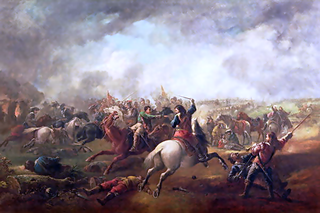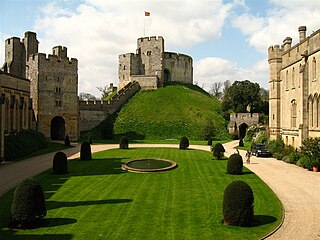
Sir William Waller was an English soldier and politician, who commanded Parliamentarian armies during the First English Civil War, before relinquishing his commission under the 1645 Self-denying Ordinance.

Ralph Hopton, 1st Baron Hopton,, was an English politician, soldier and landowner. During the 1642 to 1646 First English Civil War, he served as Royalist commander in the West Country, and was made Baron Hopton of Stratton in 1643.

Sir John Gell, 1st Baronet was a British landowner from Derbyshire who acted as local Parliamentarian commander for most of the First English Civil War before resigning in May 1646. He was notorious for parading the body of his Royalist opponent through Derby after the Battle of Hopton Heath in March 1643.

The First English Civil War was fought in England and Wales from approximately August 1642 to June 1646 and forms part of the 1639 to 1651 Wars of the Three Kingdoms. Other related conflicts include the Bishops' Wars, the Irish Confederate Wars, the Second English Civil War, the Anglo-Scottish war (1650–1652) and the Cromwellian conquest of Ireland. Based on modern estimates, 15% to 20% of all adult males in England and Wales served in the military between 1639 to 1651 and around 4% of the total population died from war-related causes, compared to 2.23% in World War I. These figures illustrate the impact of the conflict on society in general and the bitterness it engendered.

Sir John Urry, also known as Hurry, was a Scottish professional soldier who at various times during the Wars of the Three Kingdoms fought for Scots Covenanters, Engagers and Royalists, as well as both English Parliamentarians and Royalists. Captured at Carbisdale in April 1650, he was executed in Edinburgh on 29 May 1650.

Colonel Sir Edward Rossiter, 1 January 1618 to 9 January 1669, was an English landowner, soldier and politician from Lincolnshire. He fought for the Parliamentarians in the Wars of the Three Kingdoms and was an MP at various times between 1646 and 1660.

Colonel John Birch was an English soldier and politician, who fought for the Parliamentarian cause in the First English Civil War, and sat in the House of Commons at various times between 1646 and 1691.

The Battle of Cheriton of 29 March 1644 was an important Parliamentarian victory during the First English Civil War. Sir William Waller's "Army of the Southern Association" defeated a Royalist force jointly commanded by the Earl of Forth and Sir Ralph Hopton. Defeat ended Royalist hopes of retaking South East England and forced them onto the defensive for the rest of 1644.

The Battle of Powick Bridge was a skirmish fought on 23 September 1642 just south of Worcester, England, during the First English Civil War. It was the first engagement between elements of the principal field armies of the Royalists and Parliamentarians. Sir John Byron was escorting a Royalist convoy of valuables from Oxford to King Charles's army in Shrewsbury and, worried about the proximity of the Parliamentarians, took refuge in Worcester on 16 September to await reinforcements. The Royalists despatched a force commanded by Prince Rupert. Meanwhile, the Parliamentarians sent a detachment, under Colonel John Brown, to try to capture the convoy. Each force consisted of around 1,000 mounted troops, a mix of cavalry and dragoons.

The Battle of Sourton Down was a successful Parliamentarian ambush at Sourton Down, in South West England, on 25 April 1643, during the First English Civil War. After a failed attack on Royalist-held Launceston, the Parliamentarians fell back on their base at Okehampton, pursued by a Royalist army under Sir Ralph Hopton, who marched overnight, planning to attack the town at dawn.
![<span class="mw-page-title-main">Thomas Mytton</span> Welsh [[Puritan]], soldier and politician (ca.1597-1656)](https://upload.wikimedia.org/wikipedia/commons/thumb/3/35/Thomas_Mytton_Harding.jpg/245px-Thomas_Mytton_Harding.jpg)
Major General Thomas Mytton, also spelt Mitton, 1597 to November 1656, was a lawyer from Oswestry who served in the Parliamentarian army during the Wars of the Three Kingdoms and as MP for Shropshire in the First Protectorate Parliament.
Richard Norton of Southwick Park, was an English landowner and politician who sat in the House of Commons at various times between 1645 and 1691. He was a colonel in the parliamentary army in the English Civil War and for a time he commanded the Parliamentary forces besieging Basing House. He was Governor of Portsmouth for Parliament during the Civil War and for Charles II after the Restoration.

The siege of Basing House near Basingstoke in Hampshire, was a Parliamentarian victory late in the First English Civil War. Whereas the title of the event may suggest a single siege, there were in fact three major engagements. John Paulet, 5th Marquess of Winchester owned the House and as a committed Royalist garrisoned it in support of King Charles I, as it commanded the road from London to the west through Salisbury.

The siege of Plymouth took place during the First English Civil War, when Royalist forces besieged Plymouth, in Devon, held by a Parliamentary garrison.

Sir Humphrey Bennet (1605–1667) was a Hampshire landowner who fought for the Royalists in the First English Civil War, in which he rose to the command of a cavalry brigade. He went into exile in 1645, returned home in 1646 and was active in a number of Royalist conspiracies during The Protectorate.

The Storming of Farnham Castle occurred on 1 December 1642, during the early stages of the First English Civil War, when a Parliamentarian force attacked the Royalist garrison at Farnham Castle in Surrey. Sir John Denham had taken possession of the castle for the Royalists in mid-November, but after the Royalists had been turned back from London at the Battle of Turnham Green, a Parliamentarian force under the command of Sir William Waller approached the castle. After Denham refused to surrender, Waller's forces successfully stormed the castle. They captured it in under three hours, mostly due to the unwillingness of the Royalist troops to fight. This allowed the Parliamentarians to get close enough to breach the gates, after which the garrison surrendered.
The siege of Dundee took place from 23 August to 1 September 1651 as part of the Anglo-Scottish war of 1650–1652 after an English force under George Monck confronted the town of Dundee in Scotland and its garrison commanded by the town's governor, Robert Lumsden. An English army under Oliver Cromwell had invaded Scotland on the orders of the republican Commonwealth the previous year and defeated the Scots at the Battle of Dunbar. In July 1651 the Scots were defeated again, at the Battle of Inverkeithing, and their capital, Perth, captured. In desperation the Scots, commanded by David Leslie and King Charles II, invaded England with what remained of their army. Cromwell followed with most of the English force, leaving Monck with 5,000 men to mop up the remaining resistance in Scotland.

The Siege of Arundel took place during the First English Civil War, from 19 December 1643 to 6 January 1644, when a Royalist garrison surrendered to a Parliamentarian army under Sir William Waller.

The Battle of Bramber Bridge was a minor skirmish that took place on 13 December 1643, during the First English Civil War. A Royalist detachment from Arundel attempted to secure the bridge over the River Adur at Bramber in West Sussex, but found a Parliamentarian force already in possession.

The siege of Exeter (1642) or First Siege of Exeter took place during the First English Civil War from late December 1642 to early January 1643 when Royalists led by Sir Ralph Hopton attempted to capture the port of Exeter from the Parliamentarians.













![<span class="mw-page-title-main">Thomas Mytton</span> Welsh [[Puritan]], soldier and politician (ca.1597-1656)](https://upload.wikimedia.org/wikipedia/commons/thumb/3/35/Thomas_Mytton_Harding.jpg/245px-Thomas_Mytton_Harding.jpg)






